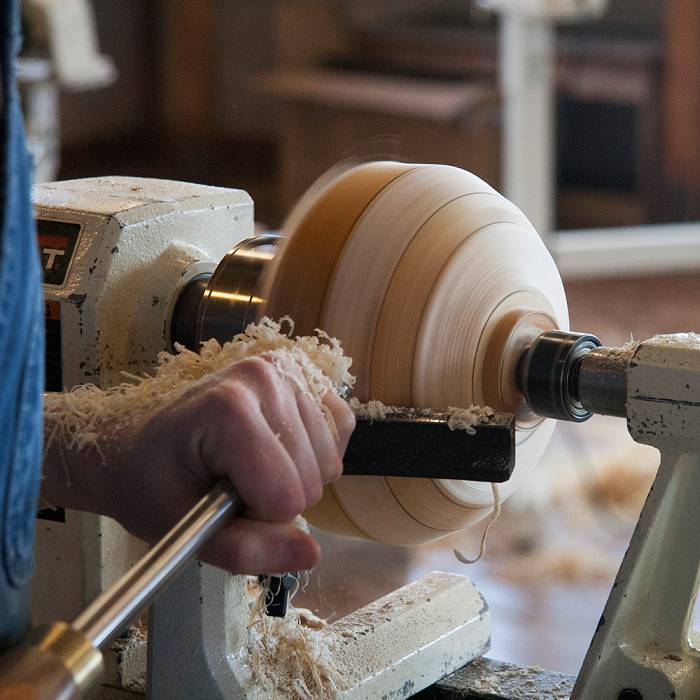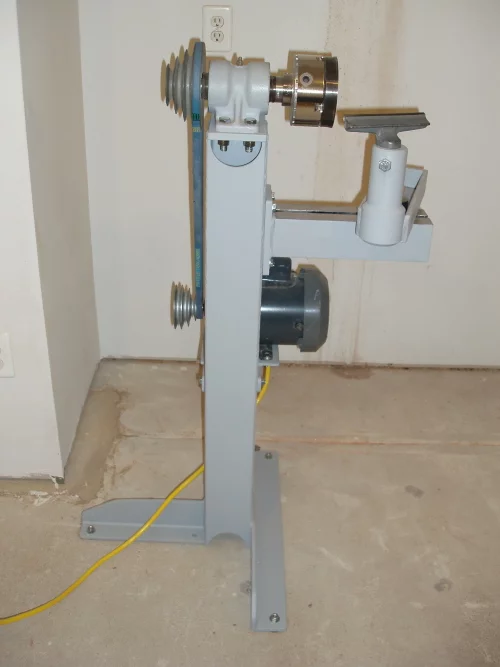Table of Contents
A bowl turning lathe is a specialized machine used for shaping and hollowing wooden bowls. It ensures precision and smooth finishes.
A bowl turning lathe is an essential tool for woodworkers who craft wooden bowls. This machine allows for precise shaping and hollowing of wood, creating smooth and symmetrical bowls. The lathe operates by rotating the wood piece at high speeds, enabling the user to carve and shape it with various tools.
Woodturning enthusiasts and professional craftsmen alike appreciate its ability to produce consistent and high-quality results. Investing in a good bowl turning lathe can significantly enhance your woodworking projects, offering both efficiency and precision. Whether for hobbyists or professionals, mastering the use of a bowl turning lathe can elevate your craftsmanship to new levels.

Credit: www.winburn.com
Introduction To Bowl Turning
Bowl turning is a fascinating craft. It involves shaping wood on a lathe. A lathe spins the wood fast. The woodworker uses tools to carve the wood. This creates a beautiful bowl. Each bowl is unique. The wood’s grain and knots add character. Bowl turning requires skill and patience. It can be very rewarding.
Bowl turning has been around for centuries. Ancient cultures used simple tools. They crafted bowls for daily use. Over time, the tools improved. Modern lathes are precise and powerful. Woodworkers today can create intricate designs. The art of bowl turning continues to evolve. It is a timeless craft.
Choosing The Right Lathe For Bowl Turning
Wood lathes come in many types. Benchtop lathes are small and easy to use. Midi lathes are bigger and offer more power. Full-size lathes are the largest and most powerful. Each type has its own benefits. Benchtop lathes are good for small projects. Midi lathes are great for medium-sized bowls. Full-size lathes handle large and heavy pieces.
A good lathe should have a strong motor. The motor should be at least 1 horsepower. Variable speed control is important. It lets you change the speed easily. The swing capacity should be big enough for your bowls. Sturdy construction ensures the lathe doesn’t wobble. Easy tool rest adjustments help with precision. A reliable tailstock keeps your work steady.
Essential Tools For Bowl Turning
Bowl turning needs sharp chisels and gouges. These tools help shape the wood. Different sizes and shapes of chisels make different cuts. Bowl gouges have a deep flute. This flute helps in removing large amounts of wood. It’s important to keep these tools sharp. Sharp tools make clean cuts and smooth surfaces.
Accurate measuring and marking are key for bowl turning. Calipers help measure the thickness of the bowl walls. Rulers and tape measures ensure correct dimensions. Marking gauges and pencils help draw lines on wood. These lines guide the cuts. Using these tools ensures the bowl is symmetrical and well-proportioned.
Preparing The Wood Blank
Choosing the right wood is important. Hardwoods like maple and oak are good choices. Softwoods like pine are easier to turn. Each wood has its own look and feel. Grain patterns can make your bowl unique. Avoid wood with many knots. They can make turning harder.
Cut the wood into a square or round shape. Make sure it’s a bit larger than your final bowl size. Use a bandsaw or chainsaw for this. Mount the wood blank on the lathe. Center it well to avoid wobbling. Secure it tightly with the lathe chuck.
Start the lathe at a low speed. Check the balance. Adjust if needed. Always wear safety gear like goggles and gloves.
Basic Techniques For Shaping A Bowl
Start by mounting the wood block on the lathe. Use a roughing gouge to remove excess wood. This helps to form a rough shape of the bowl. Work slowly to avoid mistakes. Make sure to wear safety goggles. Keep your tools sharp for better results.
Switch to a bowl gouge for finer details. Smooth out the rough edges. Check the shape frequently. Adjust as needed to get the desired form. Sand the bowl to remove any tool marks. Use finer grit sandpaper for a smoother finish. Always keep the lathe running at a safe speed.

Credit: www.shopearchitect.com
Advanced Bowl Turning Strategies
Adding decorative elements can enhance the beauty of a bowl. Use colored inlays to create unique patterns. Woodburning tools can also add intricate designs. Another option is to use texturing tools. These tools create interesting surfaces. Paints and stains can further highlight the design. Always ensure the bowl is sanded smoothly before adding decorations. This ensures a professional finish.
Creating thin walls requires precision and careful control. Start by using sharp tools. These tools reduce the risk of tearing the wood. Take small, light cuts to gradually thin the walls. Measure the thickness often to maintain uniformity. Using a caliper helps in this process. Working slowly and carefully is key. This ensures the walls are even and smooth. Thinner walls make the bowl look elegant.
Finishing Your Bowl
Start with a coarse sandpaper to remove rough spots. Use finer sandpaper for a smooth surface. Always sand with the grain of the wood. This prevents scratches. Keep the bowl steady while sanding. Check for smoothness by touching the surface. Repeat sanding if necessary. Make sure to remove all dust before applying finish.
Choose a finish that suits your bowl. Apply a thin coat first. Let it dry completely. Sand lightly with fine sandpaper between coats. Apply at least two coats for durability. Use a soft cloth to apply polish. Buff the bowl to a shine. Ensure a consistent finish for a professional look.
Safety Tips And Best Practices
Always wear safety goggles to protect your eyes. Ear protection is important to prevent hearing damage. Gloves help keep your hands safe. A dust mask protects your lungs from fine particles. Use a face shield for extra protection. Proper footwear can prevent foot injuries. Ensure all gear is in good condition.
Keep your lathe clean and free of dust. Regularly inspect the lathe for any damage. Lubricate moving parts to ensure smooth operation. Tighten all bolts and screws regularly. Replace worn-out parts immediately. Use only sharp tools for better results and safety. Store tools properly to avoid accidents.
Troubleshooting Common Bowl Turning Problems
Cracks and splits can ruin a bowl. Always check the wood before starting. Use dry wood to avoid splits. If cracks appear, use CA glue to fill them. Apply glue carefully and sand the area smooth. This will help the bowl stay strong.
Tool catch happens when tools dig into the wood. Maintain a sharp edge on tools. Keep the tool rest close to the work. Use a light touch to prevent catching. Always move the tool slowly and steadily. This will create a smooth surface.
Inspiration For Your Next Projects
Explore a collection of beautiful bowl designs. Each bowl shows unique shapes and patterns. Some bowls have smooth curves, while others have sharp edges. Colors range from natural wood to vibrant paints. Many designs use different types of wood. Each piece tells its own story.
Try using different tools on your lathe. Experiment with various cutting angles. Use texturing tools to add patterns. Combine different woods for a unique look. Try out colored dyes to enhance the wood. Practice makes perfect!

Credit: northhouse.org
Frequently Asked Questions
What Kind Of Lathe Do I Need To Turn Bowls?
You need a woodturning lathe with a robust motor and variable speed control. Ensure it has a swiveling headstock and sturdy construction for stability. A bowl gouge is also essential.
How Long Does It Take To Turn A Bowl On A Lathe?
Turning a bowl on a lathe typically takes 1 to 3 hours. The time depends on the bowl’s size and complexity.
What Is The Best Rpm For Bowl Turning?
The best RPM for bowl turning ranges from 500 to 1000. Start slow and increase speed as needed. Always prioritize safety and control.
How Big Of A Bowl Can You Turn On A 12 Lathe?
You can turn a bowl up to 12 inches in diameter on a 12-inch lathe. Ensure the lathe’s swing capacity matches the bowl size.
Conclusion
Mastering bowl turning lathe techniques enhances your woodworking skills. This craft offers creativity and precision. Invest in quality tools and practice regularly. Enjoy the satisfaction of creating unique, handcrafted bowls. Start your bowl turning journey today and experience the joy of woodworking.
